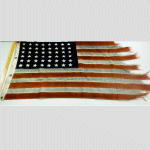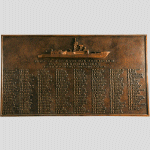Click On Image
For Full Size Image |
Size |
Image Description |
Contributed
By And/Or Copyright |
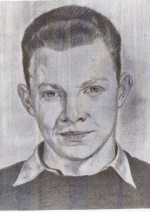

|
207k |
Samuel Booker Roberts was born in San Francisco, Cal. on 12 May 1921 and enlisted in the U.S. Naval Reserve in 1939. Called to active duty in 1940, he served
in USS California (BB 44) and USS Heywood (APA 6) before being transferred to the troop transport USS Bellatrix (AKA 20).
In 1942, Bellatrix was assigned to Task Group Four and became part of the Guadalcanal Assault Force. As a coxswain for one of the Bellatrix’s assault (Higgins)
boats, Roberts became extensively involved in the landing of Marines ashore and the transporting of supplies from ships at sea to what was a very tenuous beachhead. As a result of the heavy
fighting at sea beginning 7 August, Coxswain Roberts was transferred to the Beachmaster unit on the island of Guadalcanal to perform transport and medevac duties. Early on the morning of
27 September 1942, Roberts volunteered for a rescue mission to save a company sized unit of marines who had been surrounded by a numerically superior Japanese force. Initially the rescue
group of several Higgins boats were taken under heavy enemy fire and was perilously close to failure. Realizing the state of the rescue mission, Roberts unselfishly volunteered to distract
the Jap forces by passing directly in front of their lines and drawing their fire. The decoy act was performed effectively until all the Marines had been evacuated. However, as he was about
to withdraw from the range of the Japanese guns, Roberts‘ boat was hit and he was mortally wounded. For his valor and courage in the face of enemy fire Coxswain Samuel Booker Roberts was
posthumously awarded the Navy Cross.
USS Samuel B. Roberts (DE 413) (April-October 1944) was the first ship named in his honor, she was succeeded by
DD 823 (1946 - 1970) and FFG 58 (1986-2015).
(U.S. Navy Photo, a pencil drawing from the National Archives) |
Robert M. Cieri |
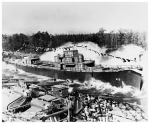 |
285k |
20 January 1944: Houston, Tex. - Samuel B. Roberts (DE 413) leaving the ways at Brown Shipbuilding Company.
(U.S. Navy photo #NH 82850 from the Naval History and Heritage Command) |
Mike Green
Port Angeles, Wash. |
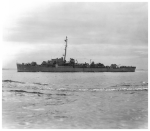 |
219k |
USS Samuel B. Roberts photographed in 1944, probably circa June, while off Boston, Massachusetts.
(U.S. Navy photo #NH 90603 courtesy of Robert F. Sumrall, 1980, from the Naval History and Heritage Command) |
Mike Smolinski
Clifton, N.J.
Archive Manager
DE / FF / LCS Archive
Navsource |
 |
213k |
October 1944: the Pacific Ocean - Samuel B. Roberts at sea, wearing camouflage design 32/22D. Taken from USS Walter C. Wann (DE 412) in October 1944,
a week or two before she was lost in the Battle off Samar on 25 October 1944.
(U.S. Navy photo #NH 96011 Courtesy of the USS Samuel B. Roberts Survivors Association, 1986, from the Naval History and Heritage Command) |
C. Lee Johnson
Ships of the U.S. Navy in Dazzle Camouflage |
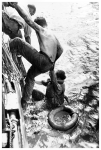 |
297k |
26 October 1944: the Pacific Ocean - American survivors of the battle are rescued by a U.S. Navy ship on 26 October 1944. Some 1200 survivors of USS Gambier Bay
(CVE 73), USS Hoel (DD 533), USS Johnston (DD 557) and USS Samuel B. Roberts (DE 413) were rescued during the days following the action.
(U.S. Army Signal Corps Collection, National Archives photo #SC 278010 photographed by U.S. Army Private William Roof, from the Naval History and Heritage Command)
|
Mike Smolinski
Clifton, N.J.
Archive Manager
DE / FF / LCS Archive
Navsource |
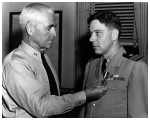 |
169k |
16 July 1945: Norfolk, Va. - Lieutenant Commander Robert W. Copeland, USNR, receives the Navy Cross from Rear Admiral David M. LeBreton, at Naval Base, Norfolk, Virginia. Lcdr.
Copeland received the Navy Cross for heroism while in command of USS Samuel B. Roberts (DE 413) during the Battle off Samar on 25 October 1944. Robert Witcher Copeland was born at
Tacoma, Washington on 09 September 1910. He enlisted in the Naval Reserve in 1929, and was commissioned as a Naval Reserve officer in 1935. Copeland practiced law from 1935 until 1940, when he
was ordered to active duty during the Navy's pre-World War II expansion. During the War, he commanded USS Pawtucket (YT 7), USS Black Douglas (PYc 45), USS Wyman
(DE 38) and USS Samuel B. Roberts (DE 413). Following World War II, Copeland resumed his law career while remaining a member of the Naval Reserve, in which he rose to the rank of Rear Admiral.
Robert W. Copeland died at Tacoma, Washington, on 25 August 1973. In 1979, the guided missile frigate USS Copeland (FFG 25) was
named in his honor.
(U.S. Naval Historical Center photo #NH 90677 courtesy of Mrs. Harriet N. Copeland, 1980, from the Naval History and Heritage Command)
|
 |
522k |
24 June 2022: from CNN Travel
It lurks over four miles deep below the Pacific Ocean, split in half and lodged on a slope.
There's a new world's deepest shipwreck to be identified and surveyed -- and it's the Destroyer Escort USS Samuel B. Roberts (DE-413), known as the Sammy B.
Victor Vescovo, an explorer who has previously completed expeditions to the world's deepest points, located the wreck together on June 22.
It lies at a depth of 6,895 meters (22,621 feet), in the Philippine Sea. By comparison, Mount Kilimanjaro's peak is 5,896 meters, while the highest permanent settlement in the world, La Rinconada in the Peruvian Andes, is 5,100 meters (16,700 feet).
Previously, the deepest wreck ever identified and surveyed was the USS Johnston, found last year by Vescovo. That lies at 6,469 meters.
Vescovo, the pilot, and sonar specialist Jeremie Morizet, dove down to trace the wreck from end to end. It has broken into two pieces, lying about 10 meters (33 feet) from each other.
The Sammy B. sank in the Battle off Samar, on October 25, 1944, in which the US Navy defeated the larger Japanese fleet, east of the island of Samar in the Philippines. It fought three Japanese
battleships, including the Yamato, said to be the largest ever constructed. The US ship carried 224 crewmembers, 89 of whom were killed. Captain Robert W. Copeland was one of the survivors.
The ship "fought ferociously even though she was completely outclassed by the Japanese battleships and heavy cruisers she went up against," Vescovo told CNN.
"The heroism of her captain and crew is legendary in the Navy, and it was a great honor to find her final resting place. I think it helps bring closure to the story of the ship, for the families
of those who were lost and those who served on her. I think that having a ship vanish into the depths, never to be seen again, can leave those affiliated with the ship feeling a sense of emptiness.
"Finding the wrecks can help bring closure, and also bring details about the battle that perhaps we didn't know before. As we say, 'Steel doesn't lie.'"
Vescovo, the founder exploration company Caladan Oceanic, and a team from EYOS Expeditions made six dives over eight days looking for the ship, as well as for another US ship, the Gambier Bay.
Previous records pointing to the ships' location had been inaccurate, but the team were helped by a custom-built sidescan solar system, as well as exhaustive research.
Initially they located debris from the Sammy B. -- a three-tube torpedo launcher, which it was the only one of the sunken ships to have. On the final day, they located the wreck.
Vescovo called it an "honor" to find the ship, saying in a statement that locating it had given the team the chance "to retell her story of heroism and duty."
"In difficult times, it's important to reflect on those who sacrificed so much, so willingly, in even more difficult times to ensure our freedoms and way of life," he said.
"I always remain in awe of the extraordinary bravery of those who fought in this battle against truly overwhelming odds -- and won."
And he told CNN that they hadn't even been sure the trip would succeed.
"The Sammy B is a small vessel as military ships go, and we weren't really sure that we could find her in the vast and extremely deep ocean where she went down. But with perseverance, some great
historical analysis, and a whole lot of deep ocean technology and hard work, we were able to find her and provide a great opportunity to tell her amazing story," he said.
"It is unbelievably thrilling to find a wreck on the bottom of the deep ocean, given all the difficulties in trying to find them. It is such an immense privilege to be the first person to see them
after they went down in battle almost 80 years ago."
Kelvin Murray, Expedition Leader and Director of Expedition Operations & Undersea Projects for EYOS said, "As ever, there's been an incredible and dedicated effort by the whole team -- the ship's
crew, sub team, historians and other specialists. Using a combination of detective work and innovative technology, everyone has pulled together to reveal the final resting place of this tenacious
ship.
"It's been a challenging, thrilling and poignant expedition, one that recognizes the ships and sailors from all nations who fought so hard during this battle. We are all proud of what has been
achieved and humbled by what we witnessed."
The team also went lower to over 7,000 meters to look for one other vessel -- a carrier, called Gambier Bay -- but were unable to find it. They didn't look for the other destroyer, USS Hoel, due
to lack of data.
But the Sammy B. might not be the deepest wreck for too long. The group thinks its new Deep Ocean Search sidescan sonar is the deepest side-scan sonar ever operated on a submersible -- normally,
they go up to 6,000 meters, but this has been tested to 11,000 meters, or full ocean depth. The Caladan Oceanic team plans to take it right to the bottom next month.
|
Bob Canchola
Contacts Research
Associate, Navsource
and
John Spivey
Proofreader
Navsource |
 |
561k |
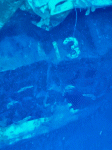 |
129k |











